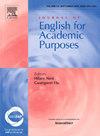Smart tools, smarter minds? Learner-AI interaction and AI assistance on critical thinking in EAP contexts
IF 3.4
1区 文学
Q1 EDUCATION & EDUCATIONAL RESEARCH
引用次数: 0
Abstract
Although AI is reshaping education, its role in fostering critical thinking (CT) in EAP instruction—especially related to learner behaviors and CT development—remains underexplored. This study involved 102 Chinese undergraduates completing three AI-assisted writing tasks designed within Wen et al.’s hierarchical CT framework. This mixed-methods study combined questionnaires, learner reflection, task observations, and interviews to investigate learners’ perceptions, interaction patterns, and CT development, with quantitative data analyzed statistically, and qualitative data thematically coded and triangulated.
Findings indicate that EAP learners perceived AI assistance as both pedagogically valuable and practically useful. Eight CT-oriented affordances of AI emerged from the data—providing references, supporting divergent thinking, synthesizing information, identifying logical gaps, enhancing clarity, stimulating metacognitive reflection, verifying data, and fostering intercultural awareness—which shaped how learners navigated tasks and positioned AI in learning. Post-task results revealed perceived improvement in CT-cognitive skills (e.g., Analyzing, Reasoning, Evaluating) and greater sensitivity to CT-intellectual standards (e.g., Logicality, Relevance). However, limited gains were observed in higher-order dimensions like Definiteness, Profundity, and Flexibility, probably due to linguistic constraints, low cognitive investment, or efficiency-driven usage patterns. Meta-CT was also minimal, with only limited traces in later tasks, highlighting the need for scaffolding to motivate reflective regulation.
The study underscores the complementary role of peer collaboration in advancing CT, particularly in open-ended, cognitively demanding tasks where AI functioned as a catalyst for inquiry rather than as a content provider. Accordingly, it proposed an “AI-triggered, peer-constructed” model to support sustainable CT development in EAP classrooms, offering guidance for AI integration in Chinese higher education.
聪明的工具,更聪明的头脑?学习者与人工智能的互动以及人工智能对EAP环境下批判性思维的帮助
尽管人工智能正在重塑教育,但它在EAP教学中培养批判性思维(CT)的作用——尤其是与学习者行为和CT发展相关的作用——仍未得到充分探索。本研究涉及102名中国大学生,他们在Wen等人的分层CT框架内完成了三个人工智能辅助写作任务。这项混合方法的研究结合问卷调查、学习者反思、任务观察和访谈来调查学习者的感知、互动模式和CT发展,定量数据进行统计分析,定性数据进行主题编码和三角化。研究结果表明,EAP学习者认为人工智能辅助在教学上有价值,在实践中也很有用。人工智能的八个面向c的启示从数据中浮现——提供参考、支持发散思维、综合信息、识别逻辑缺口、增强清晰度、刺激元认知反思、验证数据和培养跨文化意识——这些启示塑造了学习者如何导航任务和在学习中定位人工智能。任务后的结果显示,他们在ct认知技能(如分析、推理、评估)和对ct智力标准(如逻辑性、相关性)的敏感度上有了明显的提高。然而,在高阶维度(如确定性、深度和灵活性)上观察到的收益有限,可能是由于语言限制、低认知投资或效率驱动的使用模式。Meta-CT也是最小的,在后期的任务中只有有限的痕迹,突出了脚手架来激发反射调节的必要性。该研究强调了同行协作在推进CT方面的补充作用,特别是在开放式、认知要求高的任务中,人工智能的作用是作为探索的催化剂,而不是作为内容提供者。因此,它提出了一个“人工智能触发,同行构建”的模型,以支持EAP教室的可持续CT发展,为中国高等教育的人工智能整合提供指导。
本文章由计算机程序翻译,如有差异,请以英文原文为准。
求助全文
约1分钟内获得全文
求助全文
来源期刊

Journal of English for Academic Purposes
Multiple-
CiteScore
6.60
自引率
13.30%
发文量
81
审稿时长
57 days
期刊介绍:
The Journal of English for Academic Purposes provides a forum for the dissemination of information and views which enables practitioners of and researchers in EAP to keep current with developments in their field and to contribute to its continued updating. JEAP publishes articles, book reviews, conference reports, and academic exchanges in the linguistic, sociolinguistic and psycholinguistic description of English as it occurs in the contexts of academic study and scholarly exchange itself.
 求助内容:
求助内容: 应助结果提醒方式:
应助结果提醒方式:


